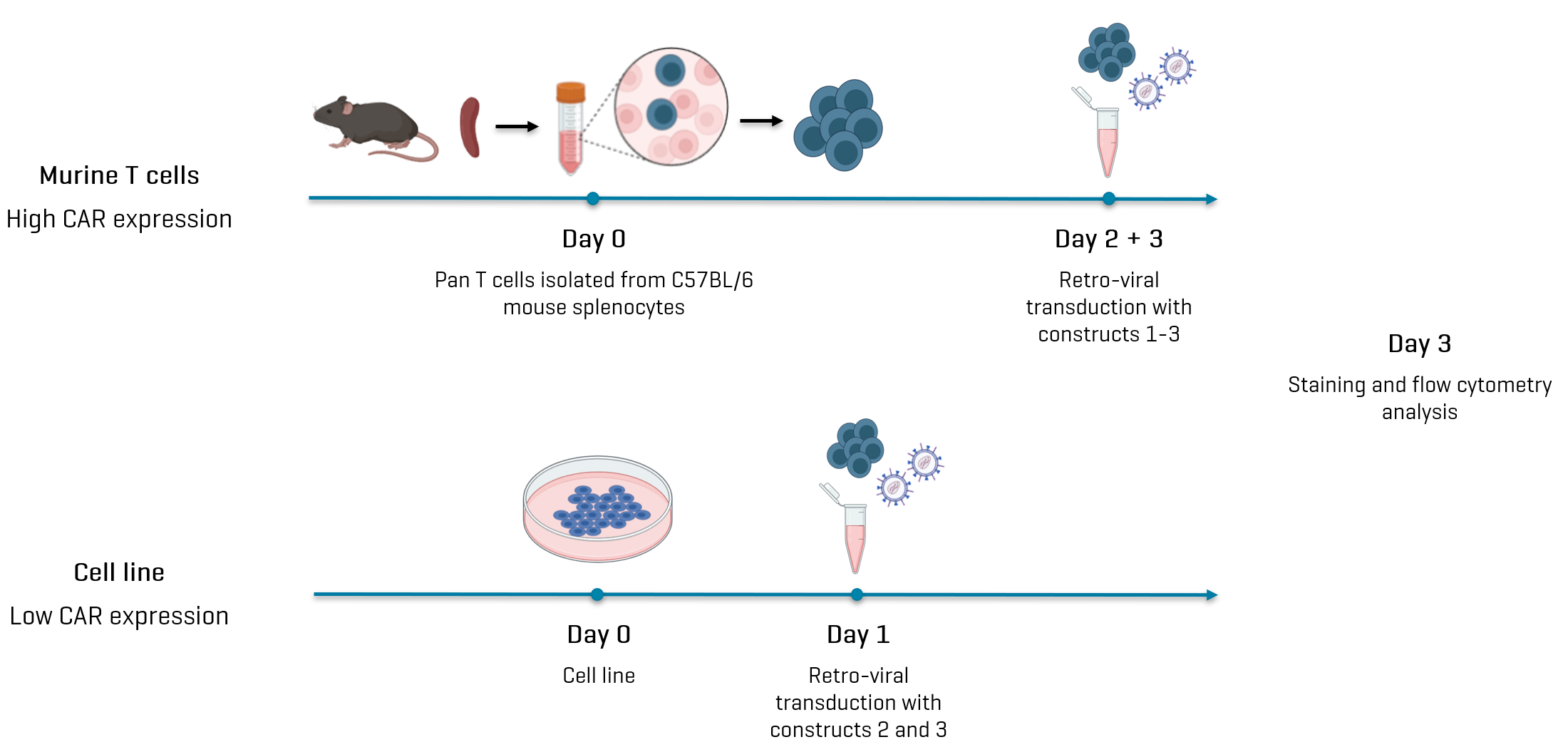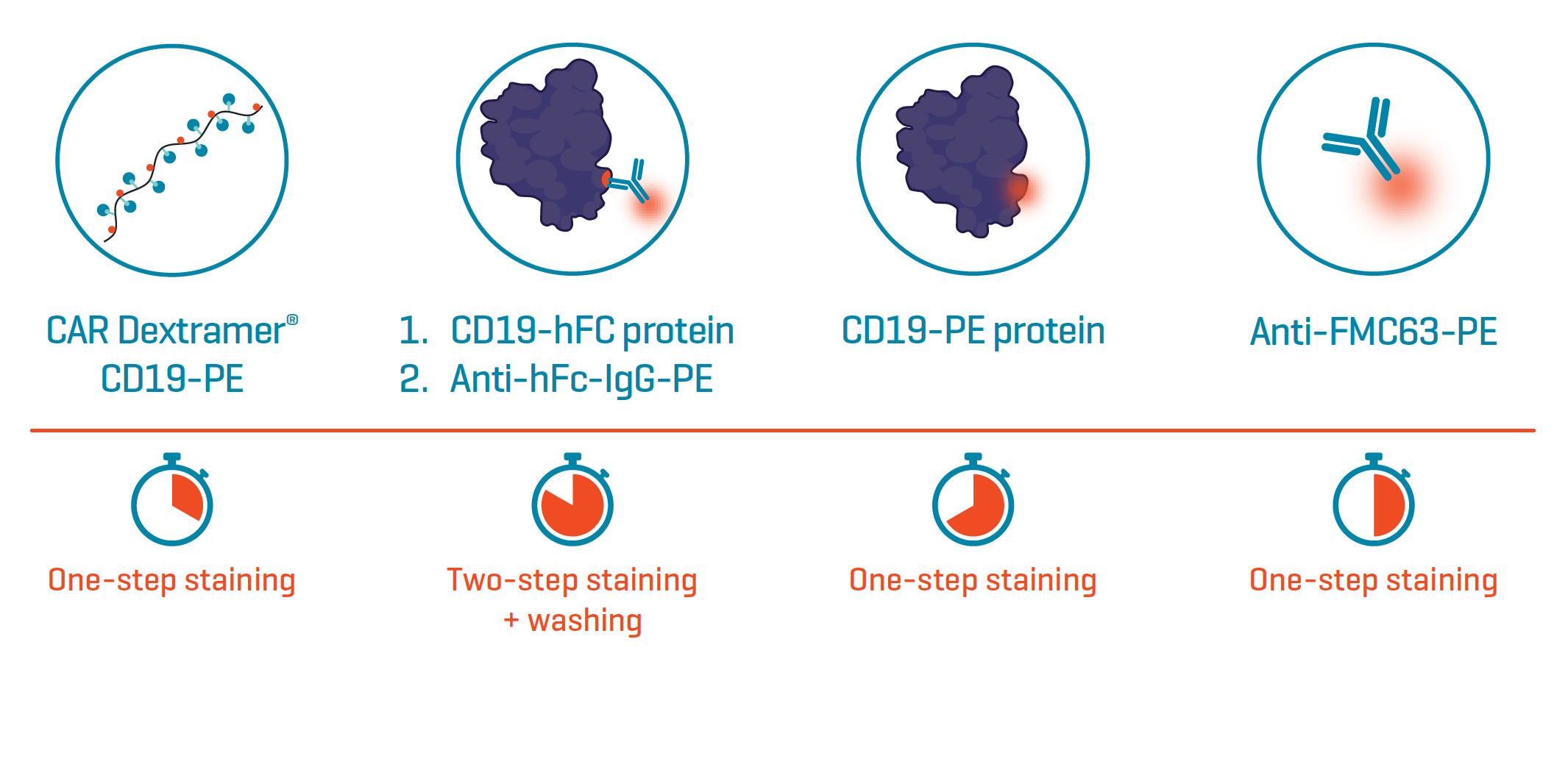- Functional detection: In addition to detection, they provide valuable information about the proper folding and functionality of the engineered receptor.
- Broad use: Offer broader specificity and application. For one, the repertoire of available reagents expands beyond well-established CAR targets like CD19 and BCMA. Secondly, each reagent will detect all CARs targeting a specific antigen easing the exploration of novel CAR constructs.
- Compatibility: they are compatible with flow cytometry panels for more comprehensive immunophenotyping.
- Direct staining: newer reagents are often directly conjugated with fluorophores, paring down staining protocols to a single step.
A Comparison of CAR Detection Reagents
The Proof is in the Staining
The ability to accurately detect and monitor CAR-engineered cells is increasingly relevant as approved CAR-T cell therapies expand in applications and the next generation of constructs tackle diseases beyond blood cancers.
Several reagents are commercially available for the detection of CAR-engineered cells. You can get an overview in our blog post “CAR-T Staining Reagents”. Among those options, antigen-based CAR detection reagents stand out for signaling the presence of a CAR based on its binding of a target antigen. Thus, these reagents detect CAR expression on a cell’s surface while also functionally confirming that the CAR can recognize its intended target.¹
Users of common antigen-based CAR detection reagents, like antigen-Fc chimeric proteins or fluorescently labeled antigen proteins, make note of their limited sensitivity. As the detection level is directly correlated with the availability of surface CAR molecules, low CAR expression might deliver a weak signal that is difficult to distinguish from background noise.
In this blog post, we present data collected by BioNTech, a collaborator interested in testing the performance of different CAR detection reagents.
Setting the Stage for a Fair Comparison
To assess the role of expression level on the signal strength of CAR detection reagents, our collaborator used cells with low and high CAR expression. The cells with high CAR expression were murine cells isolated from spleenocytes and retrovirally transduced to express one of three CAR constructs. All three constructs featured a CD19 CAR and a green fluorescent protein (GFP) reporter protein. Two of the CAR constructs (constructs 1 and 3) contained the anti-CD19 scFv FMC63. Construct 2 featured an alternative anti-CD19 scFv. The low-expressing cells were generated from a cell line transduced with one of the constructs bearing FMC63 or with construct 2 (fig. 1).

Figure 1. Generating CD19-transduced cells with high and low expression of different CAR constructs. Three different populations of high-expressing cells were generated from murine cells using three different constructs. Two of those constructs were transduced into a cell line to produce low-expressing cells.
Figure 1. Generating CD19-transduced cells with high and low expression of different CAR constructs. Three different populations of high-expressing cells were generated from murine cells using three different constructs. Two of those constructs were transduced into a cell line to produce low-expressing cells.
One or two days after transduction, the engineered cells (three high-expressing populations and two low-expressing populations) were stained with each of four commercially available CD19-specific CAR detection reagents: CAR Dextramer® CD19, a CD19-hFC protein with an anti-hFC antibody, a labeled CD19 protein, and a labeled antibody against the CD19-scFv FMC63 (fig. 2). All reagents used PE as the detection fluorophore.

Figure 2. The four commercially available CAR detection reagents compared in this study. The performance of three antigen-based detection reagents and one labeled antibody was evaluated to assess sensitivity in detecting three different CAR constructs. The lineup included direct and indirect detection, as well as uni- and multivalent detection.
Let’s see what they found out.
Strong Detection of High-Expression CAR-Engineered Cells in Half the Time
In detecting the transduced cells with high CAR expression, the CAR Dextramer® CD19 reagent and the CD19-hFC protein with an anti-hFC antibody exhibited high staining intensity and minimal background across all three constructs (fig. 3).
To continue reading this blog, please fill in your details below.
